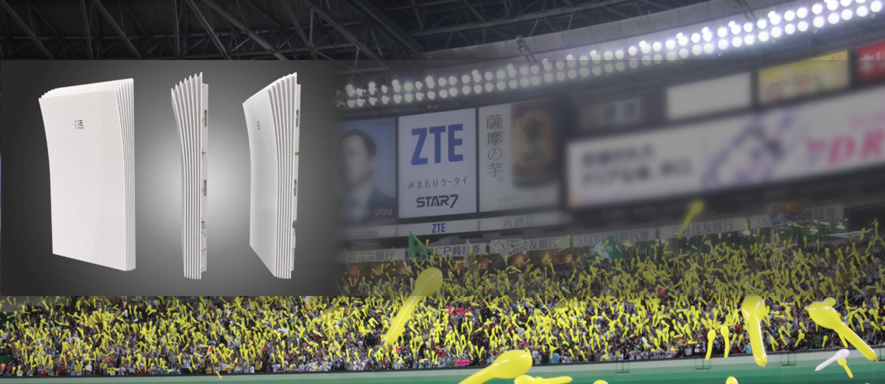ZTE Corporation, a major international provider of telecommunications, enterprise and consumer technology solutions for the mobile internet, helped Japan’s SoftBank Hawks seal a 4-3 victory over its opponent and won the championship at the main venue Yahuoku! Dome during the 2017 Japan Series.
When preparing for the match, SoftBank worked with ZTE to deploy Pre5G Massive MIMO 2.0 (antenna 64T64R) after replacing some previous Macro sites at the Fukuoka Yahuoku! Dome. Faced with high traffic, the MIMO 2.0 solution guaranteed proper communication for the whole championship and served as a comprehensive solution to the coverage, capacity, and user experience problems, helping SoftBank build a smart and high-performance gym network.
As the home field of SoftBank’s Hawks, the Fukuoka Yahuoku! Dome can hold nearly 40,000 people. Held on a magnificent scale, the championship attracted a large audience, with the attendance rate reaching nearly 100%. It also formed a network guarantee scenario with the densest communication and most concentrated services in Fukuoka recently. The high-density traffic raised serious challenges for the capacity of the existing network.
ZTE, which strove to guarantee proper communications services for the championship, carefully deployed onsite communications equipment, applied customized solutions such as simulation, onsite surveys, and optimization of core parameters (Massive MIMO antenna beamforming), and deployed Pre5G Massive MIMO 2.0 products to help SoftBank build a smart and high-performance gym.
According to relevant statistics, during the championship, the Pre5G Massive MIMO 2.0 (antenna 64T64R) accounted for 80% of the total traffic volume in SoftBank’s network. Statistics show that after the Pre5G Massive MIMO 2.0 products were deployed, the downlink aggregate traffic increased by 451.5%, the uplink aggregate traffic rose by 759.5%, and the average user uplink rate went up by 42.88%. The excellent overall performance of the Massive MIMO 2.0 network at the Yahuoku! Dome demonstrated its superb performance in high traffic scenarios.
In Tokyo, Japan, ZTE and Japan's SoftBank Group officially signed a memorandum of understanding on joint research and development of Pre5G in July 2015. In September 2016, SoftBank announced that the “5G Project”, a project based on the next-generation high-speed communications standard 5G has kicked off. SoftBank was the first operator to put the Massive MIMO technology into commercial use, with ZTE being its major supplier.
In 2014, ZTE first proposed the Pre5G concept and a series of solutions to apply key 5G technologies to 4G networks in advance and to fully enable 4G networks to evolve towards 5G networks. Compared with 4G, Pre5G enhances the system capacity by eight times, the average user bandwidth by five times, and the number of connections per unit area by 100 times. Pre5G involves not only the application of some key 5G technologies that can be put into commercial use (for example, Massive MIMO) in 4G networks but also the enhancement of LTE-A Pro technologies under the 3GPP architecture, such as Massive CA, UDN, 256QAM, LAA, LWA, and NB-IoT. Pre5G implements a smooth evolution based on the existing 4G networks, effectively lowers network construction costs, and supports rapid deployment, dramatically increasing the cost–performance ratio. In terms of the Giga + MBB, Massive IoT, and network cloudization, a combination of different technologies can be used to help operators fully upgrade from 4G to 5G network capacity.
ZTE’s Pre5G has been highly recognized in the industry. To date, its Pre5G-related products and solutions have been deployed for more than 60 networks in over 40 countries, including China, Japan, Austria, Singapore, Spain, Malaysia, Thailand, and Indonesia.





